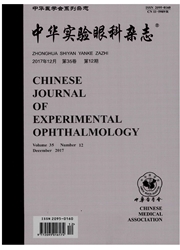

 中文摘要:
中文摘要:
背景研究表明硫酸软骨素蛋白多糖(CSPGs)是促进视皮层可塑性终止的关键因子,而最新发现酪氨酸磷酸酶蛋白受体盯(PTPa)是CSPGs发挥抑制性作用的受体,但PTPσ及其下游分子是否参与成年大鼠视皮层可塑性的再激活尚不明确。目的观察成年大鼠视皮层可塑性再激活后PTPσ、神经元周围网络(PNNs)及其下游分子N—cadherin和B—catenin的表达变化。方法选择健康SPF级LongEvans大鼠54只,按出生后周龄分为出生后1、3、5、7、9周组,各组分别有6、6、6、24、12只大鼠,其中出生后7周组12只大鼠双眼上下睑缝合14d建立视皮层可塑性再激活模型。采用免疫组织化学法观察视皮层中PTPσ、PNNs的表达情况,采用实时荧光定量PCR(real—timeQ—PCR)法分别观察PTPσ、N—cadherin和B—cateninmRNA随大鼠发育以及成年大鼠视皮层可塑性再激活后的表达变化。结果出生后9周组大鼠视皮层PTPcrmRNA的表达量明显高于正常出生后7周组和同龄双眼形觉剥夺组大鼠,差异均有统计学意义(t=1.965、3.526,P〈0.01)。大鼠视皮层中PTPσ的阳性表达定位于细胞膜、细胞质及轴突,出生后9周组大鼠视皮层Ⅱ-Ⅲ层、Ⅳ层及V~Ⅵ层PTPσ阳性细胞密度明显高于正常出生后7周组大鼠(t=24.593、23.444、13.556,P〈0.01)及双眼形觉剥夺组大鼠,差异均有统计学意义(t=44.111、43.000、16.556,P〈0.01)。出生后9周组大鼠视皮层Ⅳ层、V~Ⅵ层PNNs阳性细胞密度值较出生后7周组明显增加,差异均有统计学意义(t=1.926,P〈0.01;t=1.370,P〈0.05),而Ⅱ~Ⅲ层PNNs阳性细胞密度值比较差异无统计学意义(t=0.889,P〉0.05)。双眼形觉剥夺组大鼠视皮层Ⅱ-Ⅲ层、Ⅳ层PNNs阳性细胞密度较出生后9周组大鼠明显下降,差异均有统计学意义(t=2.556、4.185,P〈0.01),但V~Ⅵ层的PNNs阳性细胞?
 英文摘要:
英文摘要:
Background Chondroitin sulphate proteoglycans (CSPGs) can cause the termination of ocular dominance plasticity in the visual cortex. Recently, protein tyrosine phosphatase σ (PTPσ) has been identified as a receptor that inhibits CSPGs. However,whether PTPσ and its downstream molecules participate in the reactivation of ocular dominance plasticity in adult visual cortex has not been studied. Objective The present study was to investigate the changes in the expression of the PTPσ, probabilistic neural networks (PNNs), and molecules downstream of PNN, such as N-cadherin/β-catenin, after the reactivation of adult visual cortical plasticity. Methods Fifty-four SPF Long Evans rats were grouped according to different postnatal week (PW) as the PW1 (6 rats) ,PW3 ( 6 rats) , PW5 ( 6 rats) , PW7 (24 rats) , and PW9 ( 12 rats) groups, and the upper and lower eyelids were sutured in the 12 rats from the PW7 group for 14 days to establish the binocular plasticity reactivation models. Expression of PTPcr and PNNs in the rat visual cortex was detected using immunochemistry, and changes of PTPσ mRNA, N- cadherin mRNA and β-catenin mRNA expression in the rat visual cortex with plasticity reactivation were assessed by real-time fluorescence quantitative PCR (RT Q-PCR ). The use of animals followed the Regulations for the Administration of Affairs Concerning Experimental Animals by State Science and Technology Commission. Results The expression level of PTPσ mRNA was significantly higher in the PW9 group than that of the binocular plasticity reactivation models and the PW7 group ( t = 1. 965,3. 526,P〈0. 01 ). The staining of the rat visual cortex for PTPσ was localized to the cellular membrane, cytoplasm and axon. Cell densities of the PW9 group in the Ⅱ-Ⅲ layer, Ⅳ layer and Ⅴ-Ⅵ layer of the visual cortex were elevated in the PW9 rats compared with the PW7 rats (t= 24. 593, 23. 444,13. 556 ,P〈0.01 ) and rats from the binocular plasticity reactivation model (t
 同期刊论文项目
同期刊论文项目
 同项目期刊论文
同项目期刊论文
 期刊信息
期刊信息
